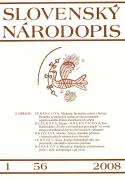Coexistence Cast in Bronze: Monuments of Significant Persons as Means of Organized Distribution of Classificatory Schemes
Spolužitie zaliate v bronze: pomníky významných osobností ako prostriedok organizovaného šírenia klasifikačných schém
Author(s): Michaela FerencováSubject(s): Anthropology
Published by: Ústav etnológie a sociálnej antropológie Slovenskej akadémie vied
Keywords: urban space; monuments; public festivities; classificatory schemes; ethnicity; local belonging; distribution of representations; local politics; bureaucratic organizations
Summary/Abstract: The study provides an account on institutional distribution of classificatory schemes. The author focuses on the role of the idea of the valuable past in the policy of the Municipal Government in the ethnically mixed town of Nové Zámky in South-Western Slovakia. She analyses the case of the revitalisation of the Main Square that represents the central public space of the town. This process undertaken in 2005 rested in the removal of old monuments and the installation of new ones. Instead of the so called "Victory sculpture" placed there in the 1960s and the bust of the avant-garde artist and the native of the town Lajos Kassák installed in the early 1990s another two statues have been placed at the Main Square: the statue of the archbishop of Esztergom Gyorgy Széchényi, and the statue of AntonBernolák who was a catholic priest and the author of the first version of Slovak literary language. The study is based on data from ethnographic fieldwork and written documents (press and official documents). The author tackles monuments as a form of public commemoration. Reffering to Sperber's epidemiology of representations as well as to the active externalist approach she considers the statues as agents in the process of the distribution of representations. She argues that the municipality representatives in Nové Zámky show a tendency to use monuments as reminders of local history compensating the lost historical appearance of the town. However, the mentioned statues represent not only significant persons of local history, but they are also interpreted as ethnic symbols: Bernolák is treated as a famous Slovak and Széchényi as a famous Hungarian. This enabled tjheir usage in the efforts topromote ethnic balance and tolerance between Slovak and Hungarian inhabitants of the town. The author concludes that such manifestation of equality compensate the subordinated status of Hungarian minority in relation of the state-nation of Slovaks. This is not always accepted by the representatives of Slovaks who tend to interpret the mentioned policy as a violation of their dominant status in "their own" nation-state.
Journal: Slovenský národopis
- Issue Year: 56/2008
- Issue No: 1
- Page Range: 5-17
- Page Count: 13
- Language: Slovak

